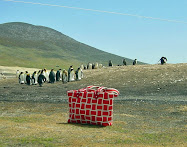
In February it was announced that Turner Prize-winning artist Mark Wallinger had been awarded the £2million public art commission to mark the Ebbsfleet International station in north Kent. It is expected that his giant sculpture of a white horse standing 50 metres high will be seen by 60m people a year and will eclipse Anthony Gormley's Angel of the North in Gateshead. It will be twice as tall as the angel and a man standing next to it will be no taller than one of the horse's hooves. The picture above is the artist's impression of how it will appear.
 The artist and maquette of White Horse © Mark Wallinger
The artist and maquette of White Horse © Mark WallingerKent County Council which commissioned the project wanted a rearing horse, which is part of the county emblem, but Wallinger made it a resolutely unheroic representation blown up in scale. It will however resonate with local history since Ebbsfleet marks the end of the horse-rearing downland country; and this was where the Anglo Saxon heroes Hengist (Stallion) and Horsa (Horse) arrived to fight the Picts around 455 AD.
Wallinger's white horse also follows the English tradition of carving such images into hillsides.
There are or were at least twenty four of these hill figures in Britain. Most of them are chalk hill carvings and Wiltshire, being the most ideal landscape, can boast thirteen of them.
Contrary to public belief they are mostly not of great antiquity. Only the Uffington horse not far across the border in Oxfordshire is certainly prehistoric, some 3,000 years old. The rest were mostly made in the last 300 years and their dates and origins are impossible to establish with certainty.
 The Uffington Horse
The Uffington Horse  The Vale of the White Horse 1939 - Eric Ravilious' image of the Uffington Horse
The Vale of the White Horse 1939 - Eric Ravilious' image of the Uffington HorseEric Ravilious ( b. 1903) a quintessentially English artist, illustrator and designer painted these figures in watercolour in the period before and after the outbreak of the Second World War.
 Train Landscape 1939 - A view of the Westbury white horse from the Vale of Pewsey
Train Landscape 1939 - A view of the Westbury white horse from the Vale of Pewsey The Westbury Horse 1939
The Westbury Horse 1939 Chalk Figure near Weymouth 1939 - cut on the downs at Osmington to commemorate the visit of George III to Weymouth
Chalk Figure near Weymouth 1939 - cut on the downs at Osmington to commemorate the visit of George III to WeymouthThe Imperial War Museum in the introduction to the exhibition Imagined Realities 2003/2004 wrote this: 'Eric Ravilious (1903-1942) is now one of the most popular artists of his period. He was a painter of watercolours and murals, a book illustrator in wood engraving and lithography, and a designer of transfer-ware pottery. He applied a dry and precise style of working to imaginative and romantic subject matter form the world around him. From 1940 he was an Official War Artist, painting memorable pictures of ships, aircraft and coastal defences, until his tragic death in a flying accident off Iceland in 1942.'
Check out the IWM's impressive site and the online exhibition here.
Image Top from The Times Online
Ravilious images from Ravilious in Public: A Guide to Works by the Artist in Public Collections Foreword by Lloyd Grossman and Introduction by Frances Spalding pub. Black Dog Books Norfolk 2002



















































































